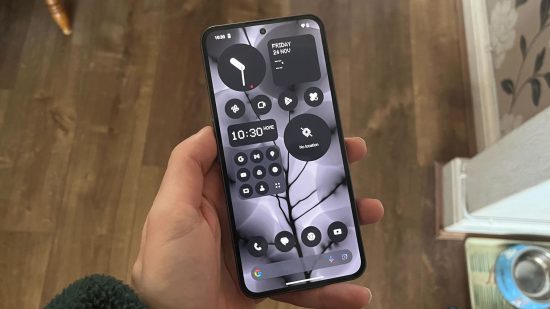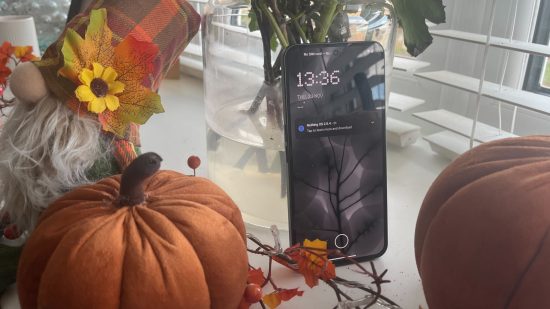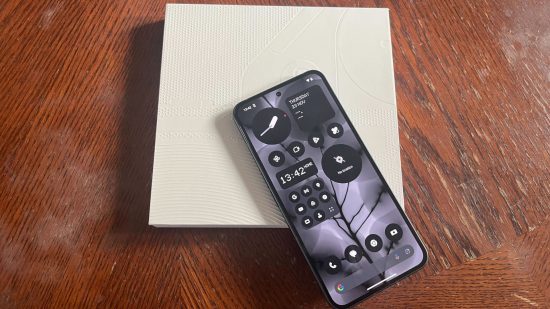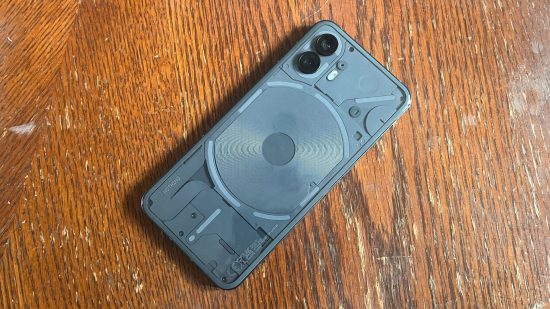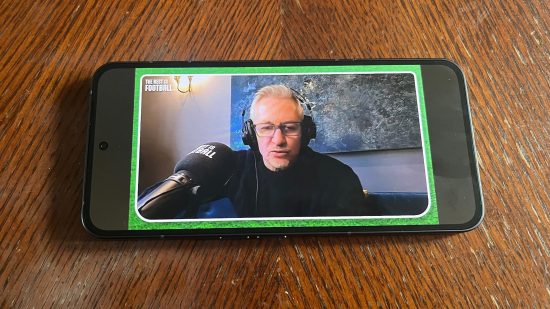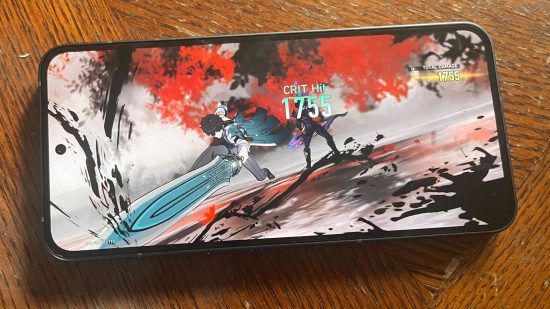Our Verdict
The Nothing Phone (2) is a solid and stylish flagship from an Android newcomer, easily rivaling other mid-range devices in terms of battery life, performance, and user experience. It isn’t perfect, though, with a disappointing water resistance rating, middling cameras, and an occasionally frustrating fingerprint sensor.
We all know the big brands when it comes to smartphones: Apple, Samsung, and the like. Still, new contenders arrive all the time, and one of the more recent smartphone start-ups is Nothing, the brainchild of OnePlus co-founder Carl Pei. While the Nothing Phone (1) impressed many due to its unique UI and design, it did leave some users wanting a mid-range model with more on offer.
Without ruining the rest of this review for you, we can confidently say that the Nothing Phone (2) is an improvement on its cheaper little brother. The display, battery life, and performance are all better. Still, there is room for further enhancements to solidify Nothing’s place as a real contender to the flagships from our guides to the best Samsung phones and the best Google Pixel phones.
Why you can trust our advice ✔ At Pocket Tactics, our experts spend days testing games, phones, tech, and services. We always share honest opinions to help you buy the best. Find out how we test.
Pros
- Standout design
- Unique Glyph feature
- Stellar battery life and performance
- Sleek custom OS
Cons
Price and availability
In terms of pricing, the Nothing Phone (2) sits comfortably alongside other mid-range phones at around the $699 mark for the standard 256GB model. That’s around the same as the OnePlus 11 and Google Pixel 8, making for an attractive price point for such an impressive design. You can pick this device up through Nothing directly or through various online retailers, including Amazon, Walmart, and others.
While there aren’t countless colors to choose from or more exciting palettes like you might get with the Google Pixel series, there is the option to pick between White or Dark Grey. I’m more of a fan of the Dark Grey, with the design combined with the UI giving some secret agent phone vibes, but it’s your call. You can check out the different prices for the different sizes below.
Specs
Features
One of the most attractive features of the Nothing Phone (2) is the unique Nothing OS Android skin. While the device gives you the option between this unique UI and the classic Android look, I felt I’d be doing this review a disservice by opting for anything else but the brand’s customized look and I’m glad I went that way. It’s cool, suave, and sleek, and better still, it perfectly captures the brand’s entire ethos in design form without losing any usability.
Admittedly, this digitized grayscale UI isn’t for everyone, and if you prefer the brightness of iOS or Samsung’s One UI, this change may take some getting used to. Still, it highlights Nothing’s desire to stand out from the swathe of Android phones and a willingness to cater to alternative tastes.
The other unique aspect of the Nothing Phone (2) is the Glyph. Admittedly, when I first heard of this feature, I thought it was just a bit of a gimmick. It is one, in a sense, but that isn’t necessarily bad. You can use the Glyph for several things, including timing your delivery driver with third-party apps, functioning as a ring light, and checking your battery, all without unlocking your phone.
Under the transparent casing, multiple LED lights make up the glyph on the back of the phone, which makes your notifications stand out. You can even create customized patterns for specific callers with the Composer app, which is much more fun than it should be, I have to say. Each part of the Glyph has its own tone, so you’re creating unique ringtones with a light show to boot. As I mentioned, it’s a gimmick, but it adds utility to the phone, even if the brand could further utilize the exciting technology.
While the Nothing Phone (2) includes a fingerprint sensor for unlocking your device, it unfortunately isn’t the most accurate I’ve used. Now, I’ve got clubbed thumbs – think big toes, but on your hands – which makes things a little more complicated, but it hasn’t ever been a problem with iPhone or other brands utilizing fingerprint technology. For me, the sensor only works occasionally. Even if I continuously vary the angle of my thumb on approach, it often doesn’t want to play ball. It’s simpler just to use a password. This issue isn’t exactly a dealbreaker, but it is disappointing.
Now, we were going to mention here that with the arrival of Nothing Chats, the Nothing Phone (2) had a feature that could put it in the higher echelons of Android hardware. However, at the time of writing, the brand has had to pull the Nothing Chats beta from the Google Play Store, citing bugs with the software. Others have put this down to security concerns, with the blame lying squarely at the feet of Sunbird, the company Nothing partnered with for the messaging venture. Whether Nothing Chats returns in the future is anyone’s guess, but it would further improve the already stellar list of features.
Design
The design of the Nothing Phone (2) is an interesting one. From the front, you might think it’s just a pretty regular Android, albeit one with a dazzling display but nothing groundbreaking. Still, flip that thing over, and this all changes. The back panel is transparent, giving you a look at the inner workings while showing off the Nothing Phone (2) Glyph.
Not only is it a slick design, but it’s a comfortable one, too. The flat frame is perfectly sized for most, while the power and volume buttons are responsive and positioned intelligently. It’s nothing innovative, sure, but it feels better in the hand than the curved OnePlus 11 or the blocky Motorola Edge 40. It’s also not slippery, so you can place it on a desk with a lean without any concern of it whizzing off like an eager teenager throwing themselves down a slip-and-slide.
My only issue with the overall design of the Nothing Phone (2) is that it feels fragile. I can’t know for sure because, as ever, I treat every review unit like a broken-winged baby bird, but I feel I have to take even more care than ever with this device. There are two reasons for that.
The first is the IP54 dust and water resistance rating, which is significantly worse than the almost industry standard IP68. While I don’t plan on dunking my review unit into any pools, it means I’m scared to put it on my desk if there’s a drink on there, and I’m certainly not going to be using it as a mini-speaker system when I’m in the shower like I do with my iPhone.
The second cause for concern in terms of durability is the phone’s back panel. While Nothing uses Gorilla Glass for the front and back, it feels fragile and likely to scratch easily. I can’t say with certainty that it is on the frail side, but I’d recommend picking up a case with this one from day one, just in case.
Display
The display is one of the areas in which the Nothing Phone (2) really shines. With a peak brightness of 1,600 nits, I mean that quite literally. There’s no lighting situation where you struggle to see the screen, from brightening up to suit reading under the sun outdoors to going way down low to do some sneaky late-night gaming without disturbing your partner. Simply put, it covers all the bases.
It’s not just bright, though. It’s crisp, utilizing an LTPO OLED to deliver high-quality video streaming and gaming, and a 6.7-inch screen perfectly suited to both. The LTPO technology also offers better battery life while using the display, making for an even more attractive handset that doesn’t suffer like others when utilizing the always-on display.
Performance
The Nothing Phone (2) utilizes the same Snapdragon 8 Gen 1 chipset as the Samsung Galaxy S22 and Xiaomi 12 Pro, offering stellar performance for the most part. The big takeaway is that this device is much quicker and more capable than the Nothing Phone (1), cementing its place as a worthy mid-range flagship capable of taking on some of the other big names at the $500-700 price point.
When it comes to gaming, the Nothing Phone (2) easily holds its own with titles like Honkai Star Rail and Marvel Snap. In fact, I’d argue it’s performing well above its price range in terms of performance, offering in-game and in-app experiences on par with much pricier devices with newer chipsets. It also plays nice with external mobile gaming controllers without any additional set-up needed to whack on something like a GameSir controller and get playing.
Battery
The Nothing Phone (2)’s battery life is stellar, easily lasting a full day with some heavy use from gaming sessions and mindlessly scrolling social media. Going from a point of 100% charge in the morning, I’d often only have to think about charging the phone around midday the following day or even later than that if I’d barely been using it.
Charging speeds for this device are also impressive, with a full charge from flat possible in just under an hour, with the option of slower wireless charging if you own the appropriate technology. However, the charger lead that comes with the handset is UBC-C to USB-C, so if you rely on USB-A chargers like I do, you may have to pick up a USB-C plug socket separately.
Camera
If you’re looking for an Android phone with incredible cameras, this isn’t the one for you. They aren’t awful, but even for someone who spends as much time writing about mobile hardware as I do, I can’t find a better way of describing them than average or decent. It also doesn’t include a telephoto lens, which is a must-have for some.
The primary camera is the best of the three, capable of catching Instagram-worthy shots of you and your pals on a night out or your beloved pet children – as seen above. Still, while the photo below of my sweet boy Floyd isn’t necessarily a bad one, it does struggle to capture the intricacies of his coat, unlike what I experienced with the Xiaomi 13T Pro. Despite multiple attempts, it could only seem to focus on his face or body, leaving a large part of him a little blurrier than I’d like. It is a little better when photographing humans, though.
The selfie and ultrawide cameras aren’t too bad, though they seem less effective at capturing dynamic range than the primary. Strangely enough, for a phone with a monochrome UI, the Nothing Phone (2) particular struggles with dark colors, which may accentuate my issues capturing my pet and his black fur. The same goes for ultrawide shots covering a long distance, with subjects in the light faring better than those engulfed in shadow, as you can see below.
Still, in saying all this, it’s worth reiterating the cameras aren’t bad, and low-light performance is better than some similarly priced devices I’ve tested. It’s just they’re distinctly mediocre in the light of day. If anything, I prefer some of the low-light examples over those taken in ideal lighting, with the second picture of Floyd below capturing his likeness better than the one from the early afternoon. However, there are still issues getting the camera to focus across his whole body, so his coat doesn’t appear as majestic as it might using a better-equipped lens.
The mediocre camera isn’t that much of an issue for me, and honestly, I’d rather have the unique aspects of this device over the flashy lenses of something like a Google Pixel. However, it’s worth pointing out for any keen smartphone photographers reading this review.
Should you buy the Nothing Phone (2)?
If you want a stylish mid-range smartphone with a unique UI and useful gimmick, the Nothing Phone (2) and its stylish Glyph are worthy of your attention. It’s also an incredibly smooth performer, whether for the day-to-day like using apps and texting or more hardware-intensive gaming. Considering this is only Nothing’s second bite of the cherry in the mobile hardware arena, it’s certainly enough to get us excited about what the company might offer as it expands and creates more products.
There are caveats, though. If you’re an amateur photographer who relies on a smartphone, the Nothing Phone (2) might not be the best tool to turn to from the mid-range options. It’s not the worst camera set-up at the price point, but there are more impressive ones with more elaborate photo editing features. Outside of the cameras, it’s also worth saying that if you prefer using a fingerprint sensor than inputting a password to unlock your phone every time you want to use it, the security measures on this phone may be a source of occasional frustration.
Alternatives
If our Nothing Phone (2) review hasn’t sold you on the Android outlier, check out some alternatives below.
Google Pixel 8
If you’re after an Android with cameras you can rely on no matter where you are or the lighting scenario, the Google Pixel 8 is the one to turn to. As our Google Pixel 8 review points out, it’s still not a perfect smartphone, but it’s capable of incredible shots and includes some photo editing features you won’t find on the Nothing Phone (2). However, it is around $100 more expensive, so you may need to stretch your budget slightly. You can get the full lowdown in our Google Pixel 8 review.
Xiaomi 13T Pro
The Xiaomi 13T Pro is one of the best phones from the Nothing founder’s previous company, with similarly impressive performance but better cameras. It might be slightly pricier, depending on where you pick it up from, but the 13T Pro is a mid-range powerhouse with more colors to pick from. Of course, it lacks the Glyph factor, but outside of that, it’s a solid alternative to anyone convinced by what the Nothing Phone (2) offers. For more details, check out our Xiaomi 13T Pro review.
